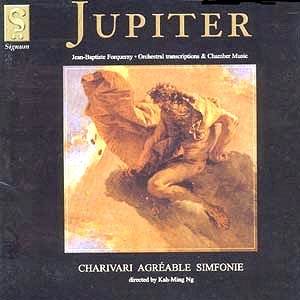 |
Jean-Baptiste Antoine
FORQUERAY (1699-1782)
|
Jean-Baptiste Antoine Forqueray was one of the leading proponents of the viol and one of the finest musicians of his time. He had a tumultuous relationship with his father, also a violist, who had him imprisoned because he was jealous of his son's talent. Three years after the death of Forqueray père, the son published a book of pieces he claimed were by his father, although it seems that he actually wrote them. This recording is an innovative reading of some of these works, arranged for an ensemble, rather than for viol and continuo (Forqueray also published a version of the same pieces for solo harpsichord.)
The music is gay and delightful, fitting in perfectly with the specific idiom of 18th century French music for the viol. Harmonically and technically these are demanding works, and melodically they are quite successful. This recording features an ensemble of from three to seven musicians, according to the individual movements. The results are somewhat mixed; at times, the ensemble fits well with the music, providing the lushness and depth it calls for, as in the third movement, the Chaconne, of the first Divertissement. The interweaving of the different instruments as the chaconne progresses is delightful, and gives the music a wonderful texture. The pardessus de viole, however, has a slightly astringent sound at times, and attracts a bit too much attention. The first movement of the fourth Divertissement, La Tronchin, might sound better with a smaller group of instruments. Its melody is less complex, and a solo viol would bring it out much better.
The first piece, called Jupiter, a moderate movement in the first Divertissement, has an uncanny resemblance to Michael Nyman's music in The Draughtsman's Contract. It has a repetitive melody, and a similar instrumental sound. Of course, Nyman used baroque music to influence his compositions for the film soundtrack; probably not this exact music, but this gives an idea of the tone.
The third Divertissement is the most restrained piece on this recording. Its three movements are all played nobly and gracefully, as marked, and are more introspective than the more lively dancing music of the other pieces. It is perhaps here that the ensemble sounds its best, with just four instruments, focusing more on the tone and melodies than trying to declaim a rhythm. There is a great deal of subtle orchestration, here; the choice of augmenting this piece, as compared to the original scoring for viol and harpsichord, is quite good.
Overall, this is a very interesting recording. The sound is a bit overdone at times; I would have preferred fewer instruments in some of the pieces. But the arrangements are interesting, and the music itself is delightful and melodically satisfying. For fans of 18th century French music, this recording is certainly recommended.
Kirk McElhearn